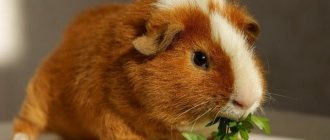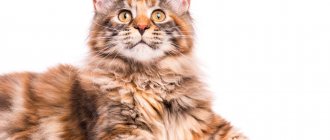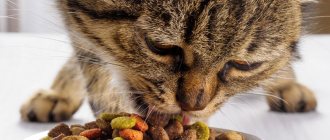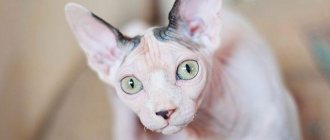03/03/2020 10,765 Hamsters
Author: Olga
A hamster is a cute and very unpretentious animal from the rodent family. How long do hamsters live? Life expectancy depends largely on their heredity and breed; they rarely live beyond three years. Therefore, when buying a hamster, you need to determine its age. The article discusses in detail the issue of life expectancy of the Djungarian hamster and the method of determining age.
[Hide]
What determines the lifespan of a Djungarian hamster?
Any external factors greatly affect the condition of a small animal, so the issue of maintenance must be taken seriously.
Care
- Provide your pet with a decent home, while taking into account the unshakable hamster rule: “ Each hamster has a separate cage . These harmless animals are actually very sensitive to the issue of their territory, and any “stranger” in their cage can lead to aggression and even a fight.
- Clean the rodent's cage in a timely manner, avoid the accumulation of garbage and excrement, the smell of which can quickly spread throughout the house.
- To prevent your small rodent from getting hurt, do not buy cotton wool for it. The hamster runs the risk of getting entangled in it, and the cotton wool can wrap around any part of the tiny body. Instead, it is better to bring napkins to the hamster's cage - this is the best option for building nests.
Give your pet the attention it needs just as much as cats and dogs.
- Protect your hamsters' ears from any noise, be it the radio, TV or loud conversations . This can create a stressful situation for your pet.
- Also exclude any bright light, which these nocturnal animals do not like. Most of all, they cannot tolerate daylight; it is also harmful for them to be in direct rays.
What should jungarika eat?
Nutrition
Healthy food is another success on the path to longevity for your pet. To do this, add the following to your animal’s diet:
- Ready-made nutritional formulations. Such kits are sold in pet stores; they represent proper balanced nutrition , which is selected specifically for hamsters. They often contain corn, wheat, peas and nuts - everything that rodents love so much.
- Fresh fruits and vegetables. Focus on zucchini and carrots, and it is better to exclude cabbage and onions, as they can harm the health of jungarians. All citrus fruits should be excluded from fruits, and apricots, bananas and apples are the most optimal for hamsters.
Protein is another substance that keeps your pet healthy. In order for the dwarf to get protein, give him meat several times a week.
- Special vitamins. It is better to discuss recommendations for their purchase directly with a specialist.
- Regularly replenish your rodent's water bowl with water. IMPORTANT: Water must be distilled.
Genes
Like humans, hamsters may have a genetic predisposition to diseases . Thus, genes sometimes result in the development of certain diseases. Therefore, when purchasing, it is better to get a hamster that had healthy parents.
Also, genetics can have a hamster's life expectancy for the better. If a rodent has long-livers in its family, then it will probably live a long time. Such a gene can also have a positive effect on the animal’s immunity.
This means that it will be more resistant to disease. The right decision would be to contact professional hamster breeders, so you can find out more about the parents of the future pet. Did you find out about your pet's pedigree before purchasing? What do Djungarians often get sick with?
Diseases
Since you are dealing with a helpless animal, you need to monitor its health very carefully. Especially if you want to ensure a long and happy life, then monitor illnesses in advance using symptoms such as:
- Decreased activity.
- Constant fatigue and lethargy.
- Drowsiness.
- Labored breathing.
- Deterioration of fur.
If one of the symptoms appears, you should immediately consult a doctor . The earlier you detect the disease, the easier it will be to get rid of it.
- The Dzungarian may catch a cold, which is usually indicated by sneezing and sniffling. In this state, the animal needs your care and attention, while feeding your pet fresh fruit - this way he will recover faster. IMPORTANT: Use any medications or injections only with a doctor’s prescription.
A problem with teeth may be indicated by the fact that the hamster is not eating well. The cause may be damage to the oral cavity or overly long incisors. Probably, because of the pain, it is simply difficult for the pet to chew food. In this situation, only a doctor can help; in some cases, the procedure to shorten the length of teeth is carried out at home.
- Djungarians may also experience intestinal and stomach diseases . This can be determined by loose stools, an unpleasant odor, or rumbling in the animal’s tummy.
- The animal may also develop a tumor disease, but you should not make hasty decisions if you just find a lump or lump. In this case, you need to consult a doctor for an accurate answer.
- Protect your pet from fractures , because a serious injury can leave your pet lame for the rest of its life. In case of watering, bruising or other damage, immediately take the hamster to the veterinarian, only he will give you the correct recommendations for recovery.
How long can a hamster live without active movement?
Like any living creature that can jump and run, the dzhungarik cannot be healthy without an active lifestyle. To keep your animal in good shape, provide it with the necessary equipment: exercise equipment, walking balls or a wheel.
Remember that a hamster will not be able to live long with plenty of food and little activity , this can lead to intestinal diseases, which can have harmful consequences. To avoid this, constantly give him space to be active, be it his crate or the floor of your apartment.
At what age is it better to buy a hamster?
Lifespan of the Djungarian hamster in nature and captivity
In addition to the province of Dzungaria, to which hamsters owe their name, they are found in Asian latitudes, as well as in the Caucasus, Siberia and Kazakhstan. Considering the miniature size of the Djungarian hamster (its height rarely exceeds 10 cm, and its weight reaches no more than 65 g), a huge number of dangers await it in the wild.
Due to the abundance of land-based and sky-borne predators, as well as the difficulty of obtaining food and weather conditions, in the wild the Djungarian hamster usually lives no more than 2 years. Most representatives of this species die in the claws of a predator much earlier.
Determining the age of the pet
The life expectancy of Djungarian hamsters is 2-3, sometimes 4 years, but this is in exceptional and very rare cases. And although this is not as much as, for example, cats or dogs, do not be sad about this, and feel free to get yourself a little furry friend, even if for such a short period of time he will become your faithful companion. Before buying an animal in a store, it is important to determine how old it is. This is quite difficult to do; even zoologists will not be able to give you an accurate answer to this question. There are several factors by which it is still possible to distinguish a small dwarf from its more adult counterpart.
- Young animals are very active and inquisitive, always strive to communicate with people, enthusiastically run around the cage and happily eat various delicacies. Older rodents are calmer and slower. They live a measured life, love to sleep and try to hide in their house.
- Its appearance will also help determine the age of the hamster. The fur of fluffies acquires its first color within a week after birth. But after 14 days it not only becomes thick and smooth, but also, as a rule, changes color to a permanent darker color.
- The age of the animals is revealed by their weight and length. Usually at 2 months the size of babies does not exceed 8 cm, and already at 5 months old the hamster weighs up to 40 g. Therefore, if you want to determine the age of your pet, you should definitely weigh and measure it.
Tips for coping with loss
After the first week, a person, seeing how restless these creatures are, becomes so accustomed to them that he can no longer imagine a day without them. Unfortunately, their physiology is such that within a couple of years they die. Naturally, every owner who is accustomed to these active animals experiences suffering. This becomes a serious blow for children who very sincerely fall in love with the little Djungarians and find it extremely difficult to come to terms with the fact that they are no longer there.
What to do if the dwarf died?
Don't try to place the blame entirely on yourself, don't torture yourself with the fact that this happened because of your mistake. You should switch your thoughts to something else : while the hamster lived in your family, he was very happy, because he was loved by all members. And it is unknown how his fate would have turned out if you had not been around. Unfortunately, not a single person is able to prolong the life of an animal more than is allotted to it by nature.
Causes of death of the domesticated dwarf
The lifespan of a Djungarian hamster at home depends on the level of care of the owner. The short life of a pet may be associated with the inattention and irresponsibility of its owner, or, on the contrary, with excessive love. These host manifestations may entail the following:
- binge eating;
- illnesses of varying severity;
- domestic injuries.
These consequences of improper handling of a pet can lead to the death of the animal.
How to extend the life of your pet
If the owner of a hamster takes care of creating good conditions for his ward, the life cycle of a domestic hamster will be as long as possible. It is important to take into account the comfort factors that are significant for the animal:
- Temperature regime.
The most pleasant temperature for dzungarians is from 20 to 25°C.
- Light and sound stimuli.
There should be no loud music or running household appliances near the rodents' home.
- Innate habits of the animal.
If a hamster hides food, this is normal; this is how dwarf hamsters behave in the wild. You should not reduce the amount of food or throw away supplies collected by your pet while cleaning the cage.
- Cleanliness of the home.
The cage is cleaned 2-3 times a week. In this case, the sand in the sand bath container must be replaced.
Important! If there are noticeable dirt on the skin of a Djungarian hamster, they are carefully removed with a damp cloth, after which the pet’s fur is dried with a towel.
It is important to always pay attention to the behavior of the animal. Djungarian hamsters cannot say what does not suit them, but they can show it through a certain state that is similar to a trance. Signs of the onset of the disease are:
- decreased physical activity;
- decreased appetite;
- change in stool;
- the appearance of problems with fur;
- breathing with an open mouth.
If the hamster falls asleep while walking, you need to warm him up, try to gently wake him up, and eliminate the factor that provokes numbness - the cold from an open window, a TV working nearby, a cat walking near the cage.
Psychologists believe that if you determine the age of a hamster in advance, this will help a person subconsciously tune in to the inevitable death of the animal in 3-4 years. However, you should not dwell on negative experiences.
How to choose a house for a hamster
Since Djungarian hamsters are rodents, it is absolutely not recommended to house them in a cage. After all, rods made of plastic or wood will very soon be chewed and completely damaged. The use of a cage with metal partitions, which will also be seriously damaged by the powerful jaws and strong teeth of the hamster, will not help.
You should use a spacious glass aquarium as a house for your pet. It is best if the container is about 70-100 centimeters long and has a height of at least 40 centimeters. There is no point in choosing an aquarium of smaller dimensions. Because the hamster will suffer from a lack of free space and insufficient fresh air circulation.
The bottom of the rodent's home should be lined with an impressive layer of sawdust. It is desirable that such a pillow have a thickness of about 3-4 centimeters. As an alternative, you can use special hamster pellets made from recycled, compressed wood.
Home maintenance
If you decide to have a Djungarian hamster at home, you must take into account the characteristics of its character and habits:
- If you have several hamsters, then each of them needs a separate house. Excessive pugnacity and aggressiveness towards their relatives will not allow even two hamsters to live together in one cage.
- When arranging a house, you need to use clean sawdust or finely cut paper as bedding. Cleaning should be done at least weekly and most of the bedding should be changed. The remaining part will be useful so that the hamster can calmly settle down and get used to a clean cage.
The cage should be placed away from open sun and bright light. This is due to the fact that most of the hamsters' wakefulness occurs in the evening and night hours, and proximity to light will disrupt the hamster's biological activity time, which can cause it to lose its appetite and get sick.
- Due to the high physical activity of the dwarf, it is necessary to install a running wheel in the cage, as well as a translucent labyrinth for climbing. Thanks to its innate cleanliness, you can not be afraid of the unpleasant odors that are characteristic of rodents, and you can hug and cherish your hamster in your arms.
Djungarian hamster
Factors influencing life expectancy
At home, your hamster will live longer if you provide it with the right nutrition . The diet may include corn, rice, buckwheat, wheat, peas, sunflower seeds and walnuts or cashews. To compensate for protein deficiency, you can add a piece of boiled chicken or fish to the menu. The volume of one meal is usually 2-3 tablespoons. You need to feed your hamster twice a day.
Another factor in a hamster’s long life is a calm emotional state . First of all, you should not move the cage from one place to another, much less change the cage. New, even small, movements and changes can cause stress in the animal, and as a result, passivity and loss of strength.
Diseases and causes of death
Despite their unpretentiousness and unpretentiousness, Djungarian hamsters can get sick from simple everyday causes: injuries, colds, problems with the eyes and teeth, the presence of fleas, peeling skin and hair loss, indigestion, tumors and neoplasms.
In any case, you should not self-medicate. The hamster's body is very sensitive and only qualified help from a veterinarian will help cope with the disease.
But sometimes even medical assistance may not have time to save the hamster. This can occur with bloating and diarrhea, which exhausts the hamster and leads to death.
Therefore, it is very important to feed your hamster only fresh and unexpired food. The hamster itself, due to its omnivorous nature, will not be able to refuse a spoiled piece, therefore only the hamster’s owner bears full responsibility for its nutrition. You should absolutely not give your hamster sugar, spices, fried and fatty foods, onions, garlic, sausages, chips, and salty crackers.
Djungarian hamster
Omnivorousness and lack of moderation often lead a hamster to obesity, which is often the cause of the animal’s premature death.
Failure to comply with the temperature regime is also the main cause of death of hamsters. Stuffiness and heat negatively affect hamsters. Hypothermia, which leads to colds, is also dangerous for animals. Therefore, it is better to provide a comfortable temperature for them of about 20-22 degrees Celsius.
Often female hamsters die during their first birth. Therefore, mating should be carried out on females no younger than 4 months of age. And during pregnancy, it is necessary to protect the female from stress and other unfavorable conditions.
Hamsters can also die from depression and stress, which cause cardiac arrest. Moreover, all hamsters are susceptible to this, regardless of age.
How many years do Djungarians live at home?
In the best case, with careful and attentive care, jungarians can live up to 3-4 years. It is necessary to understand that a month of a hamster’s life is comparable to two years of a human’s life. And with the advent of old age, the dzhungarik may fade away. The onset of old age can be determined by decreased activity, fading of the sparkle in the eyes, loss of hair on the head, decreased appetite and lack of accumulated reserves.
In this case, you can create a calm and peaceful life for the hamster, or you can go to a clinic for artificial euthanasia.











